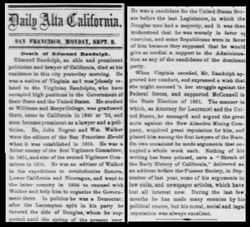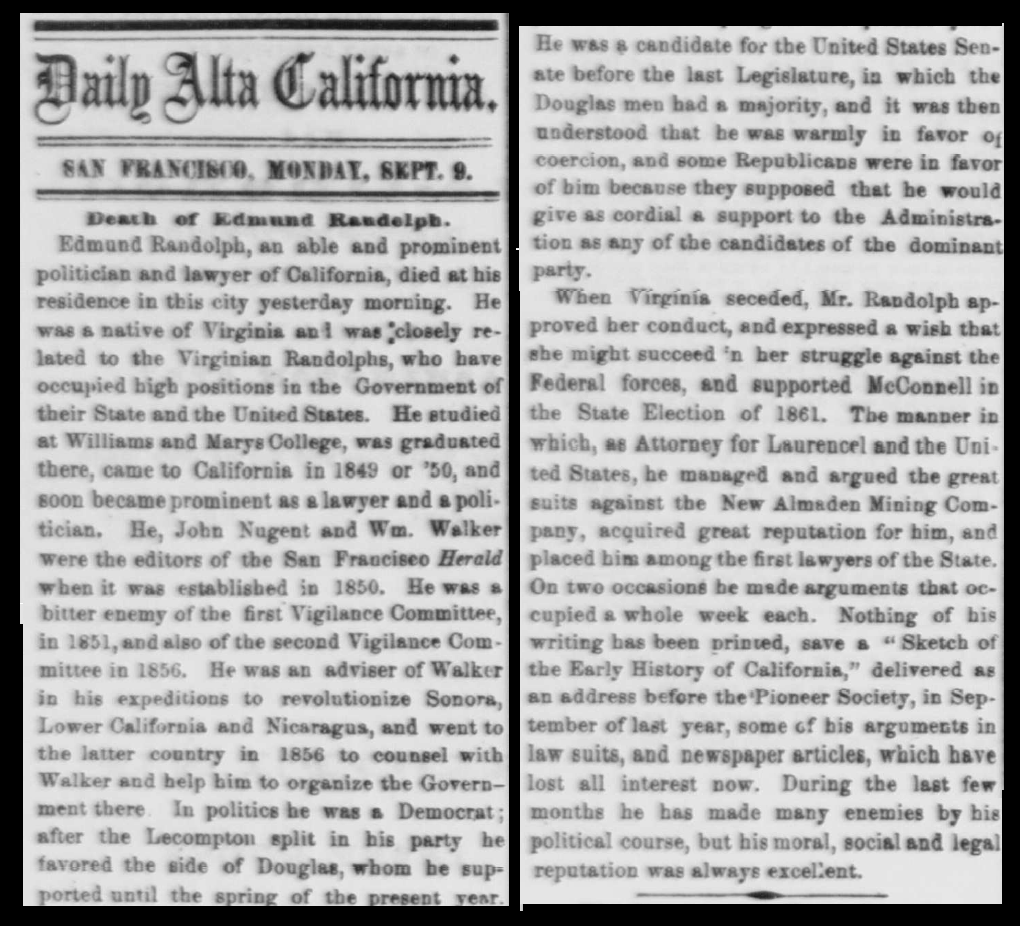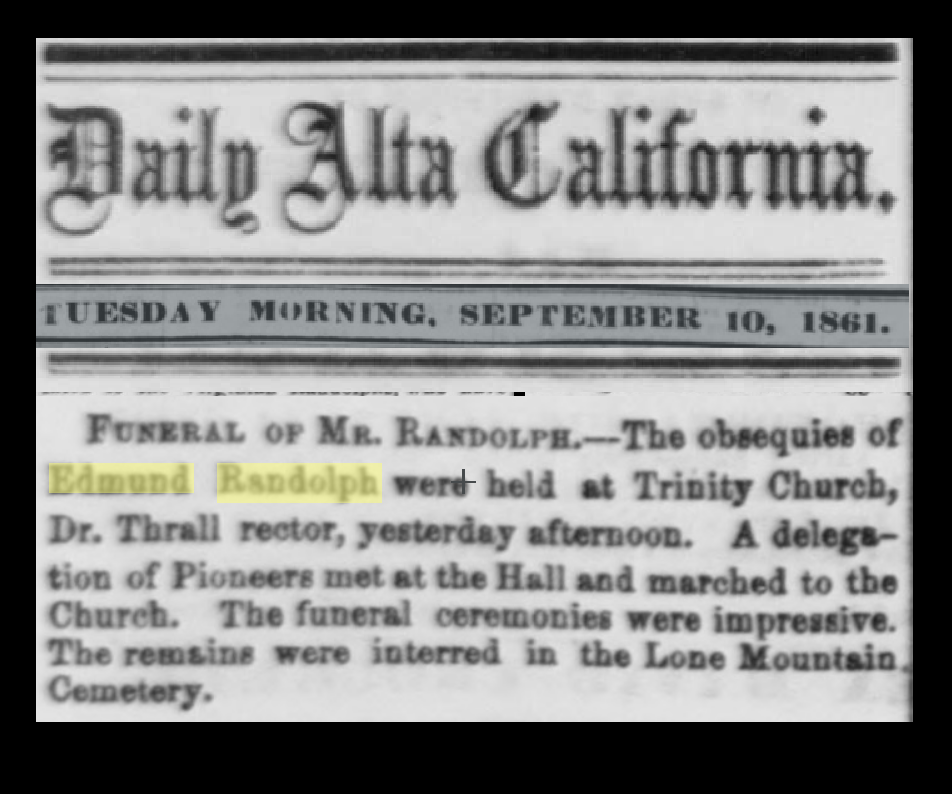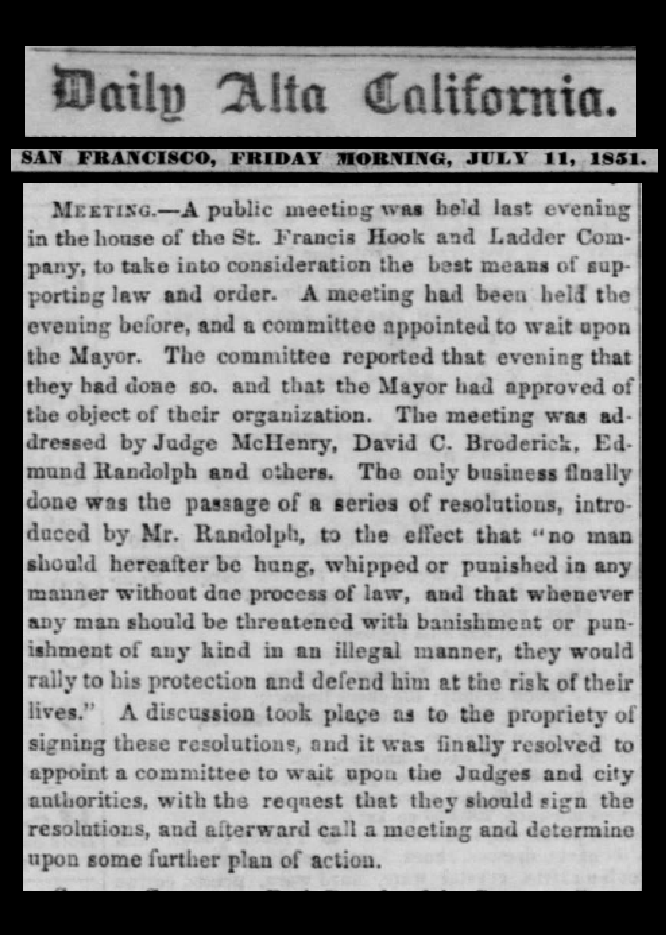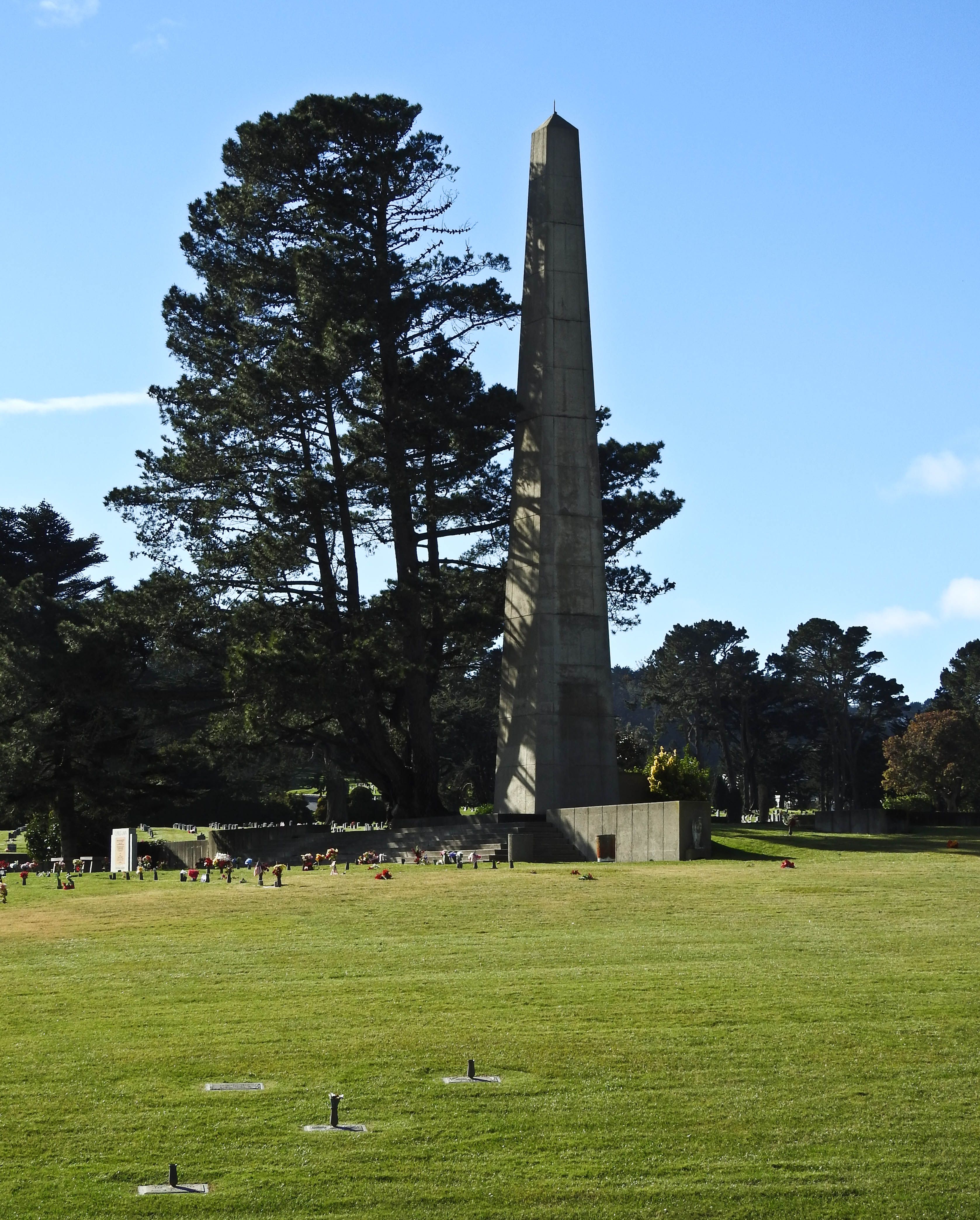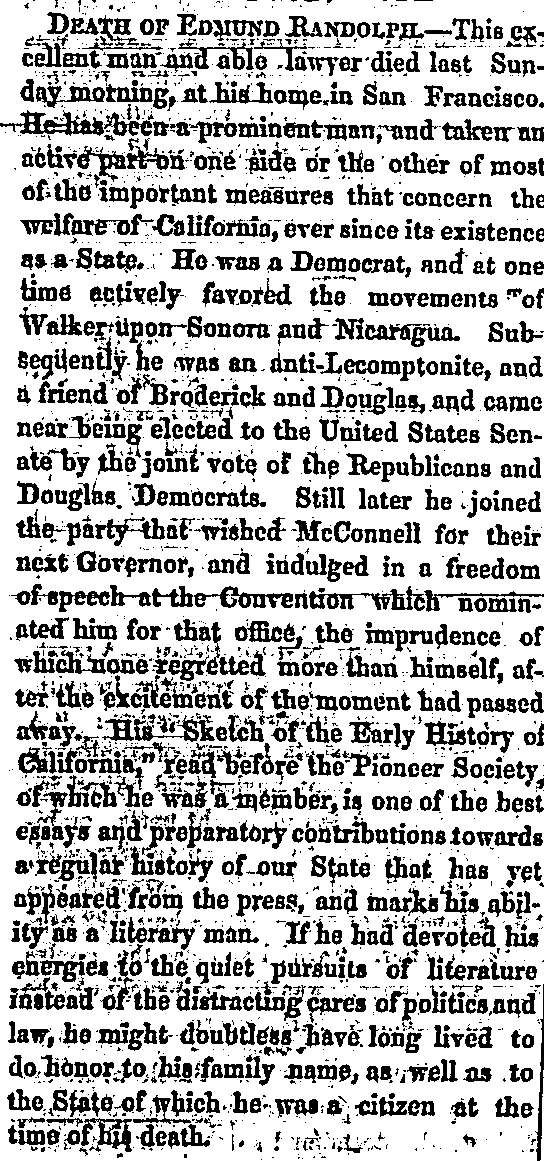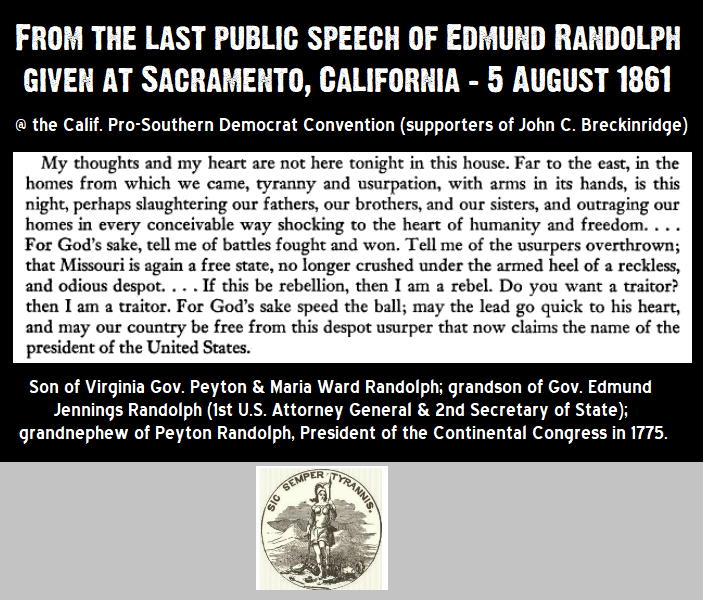Edmund came to California in 1849 and was elected to the first legislature as a member of the Assembly representing Los Angeles. It is likely there that he met Alexnader Parker "A P" Crittenden (see memorial # 49547142), who became a close friend of Edmund and for whom his fourth daughter was named.
Edmund married Tarmesia Meaux, a daughter of Dr. Thomas O. Meaux and Eliza Ettis Nash Meaux, some time before 1847 likely in Louisiana were Tarmesia was born. In the 1850 census, they had one daughter, Charlot. From the Daily Alta California, Volume 2, Number 148, 6 May 1851, page 2, column 2, was the following:
“DIED… In New Orleans, March 27, Charlotte F. Randolph, daughter of Edmund and Tarmesia Randolph, aged 3 years and 5 months.”
They had three surviving daughters: Margaret Randolph, Lucy Nelson Randolph, and Mary Crittenden "Carey" Randolph.
∼Prominent attorney from the prominent Randolph family of Virginia, one the 1850 "Legislature of a Thousand Drinks" (California's 1st Legislature after becoming a State); see attached obituary. Randolph was born in Richmond, Virginia, the son of Virginia Governor Peyton and Maria Ward Randolph. He was also the grandson of 1st U.S. Attorney General and 2nd Secretary of State Edmund Jennings Randolph, as well as grandnephew of the original Peyton Randolph, who was President of the Continental Congress in 1775. Randolph attended the College of William and Mary, and studied law at the University of Virginia. He moved to New Orleans, studying and practicing law there until 1849. He clerked for the U.S. Circuit of Louisiana. After arriving in California in 1849, he practiced law and was elected to the first Legislative Assembly of California, the "Legislature of a Thousand Drinks."
In 1853, Randolph collaborated with his old friend, Col. William Walker, to seize control of Nicaragua in 1855 and 1856. Randolph traveled to Nicaragua, where he was worked on a new constitution and set of laws for the planned new government. But before they could form a government, Randolph suffered life-threatening heart trouble (1856) and was moved to New York, where he recovered.
Randolph's heart trouble continued to make news again in February 1861. He had been a perennial candidate for office. He failed to be elected and re-elected thereafter largely more to party lines rather than his worth as a candidate, for he would earn respectable numbers of votes - just not enough to beat the winning candidate as various factions and the rise of the Know-Nothing party deeply affected California politics. He was a constant speaker for Democrat principles, being associated with pro-Union groups and Douglas Democrats - until Virginia seceded.
Then, in August 1861, Randolph gave a speech at the Breckinridge Democrat Convention in Sacramento that intensely agitated the issue of the new Confederate States and California's course. A photo with key portions of his speech is attached.
He was a close personal and political friend of the anti-slavery, pro-Douglas California Democrat leader David Colbreth Broderick until his death in 1859, having worked closely with Broderick since the times of fighting the Vigilance Committees which nearly took over San Francisco politics.
As an attorney, he was nationally known. He associated in some of the same cases with attorneys such as Reverdy Johnson, Edwin Stanton, Judah Benjamin and other leaders at the Bar.
Randolph was reinterred in the Pioneer mound at Colma, Cypress Lawn - see
Randolph's current memorial for additional biographical information and family links.
Edmund came to California in 1849 and was elected to the first legislature as a member of the Assembly representing Los Angeles. It is likely there that he met Alexnader Parker "A P" Crittenden (see memorial # 49547142), who became a close friend of Edmund and for whom his fourth daughter was named.
Edmund married Tarmesia Meaux, a daughter of Dr. Thomas O. Meaux and Eliza Ettis Nash Meaux, some time before 1847 likely in Louisiana were Tarmesia was born. In the 1850 census, they had one daughter, Charlot. From the Daily Alta California, Volume 2, Number 148, 6 May 1851, page 2, column 2, was the following:
“DIED… In New Orleans, March 27, Charlotte F. Randolph, daughter of Edmund and Tarmesia Randolph, aged 3 years and 5 months.”
They had three surviving daughters: Margaret Randolph, Lucy Nelson Randolph, and Mary Crittenden "Carey" Randolph.
∼Prominent attorney from the prominent Randolph family of Virginia, one the 1850 "Legislature of a Thousand Drinks" (California's 1st Legislature after becoming a State); see attached obituary. Randolph was born in Richmond, Virginia, the son of Virginia Governor Peyton and Maria Ward Randolph. He was also the grandson of 1st U.S. Attorney General and 2nd Secretary of State Edmund Jennings Randolph, as well as grandnephew of the original Peyton Randolph, who was President of the Continental Congress in 1775. Randolph attended the College of William and Mary, and studied law at the University of Virginia. He moved to New Orleans, studying and practicing law there until 1849. He clerked for the U.S. Circuit of Louisiana. After arriving in California in 1849, he practiced law and was elected to the first Legislative Assembly of California, the "Legislature of a Thousand Drinks."
In 1853, Randolph collaborated with his old friend, Col. William Walker, to seize control of Nicaragua in 1855 and 1856. Randolph traveled to Nicaragua, where he was worked on a new constitution and set of laws for the planned new government. But before they could form a government, Randolph suffered life-threatening heart trouble (1856) and was moved to New York, where he recovered.
Randolph's heart trouble continued to make news again in February 1861. He had been a perennial candidate for office. He failed to be elected and re-elected thereafter largely more to party lines rather than his worth as a candidate, for he would earn respectable numbers of votes - just not enough to beat the winning candidate as various factions and the rise of the Know-Nothing party deeply affected California politics. He was a constant speaker for Democrat principles, being associated with pro-Union groups and Douglas Democrats - until Virginia seceded.
Then, in August 1861, Randolph gave a speech at the Breckinridge Democrat Convention in Sacramento that intensely agitated the issue of the new Confederate States and California's course. A photo with key portions of his speech is attached.
He was a close personal and political friend of the anti-slavery, pro-Douglas California Democrat leader David Colbreth Broderick until his death in 1859, having worked closely with Broderick since the times of fighting the Vigilance Committees which nearly took over San Francisco politics.
As an attorney, he was nationally known. He associated in some of the same cases with attorneys such as Reverdy Johnson, Edwin Stanton, Judah Benjamin and other leaders at the Bar.
Randolph was reinterred in the Pioneer mound at Colma, Cypress Lawn - see
Randolph's current memorial for additional biographical information and family links.
Family Members
Advertisement
Advertisement
